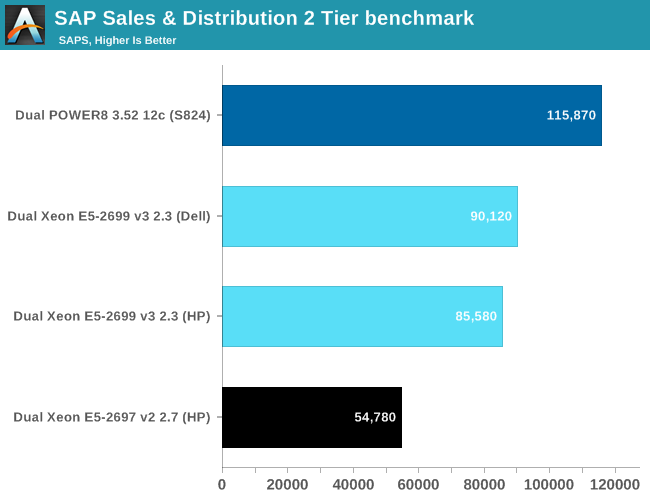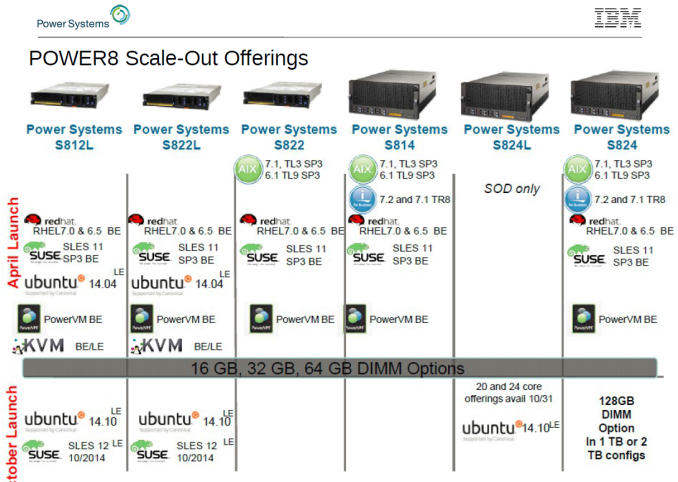The IBM POWER8 Review: Challenging the Intel Xeon
by Johan De Gelas on November 6, 2015 8:00 AM EST- Posted in
- IT Computing
- CPUs
- Enterprise
- Enterprise CPUs
- IBM
- POWER
- POWER8
Reading the Benchmarks
There are a lot of benchmarks available that compare the IBM POWER8 to Xeons. One example is the Enterprise Resource Planning (ERP) software SAP. We have used the Sales & Distribution 2 Tier benchmark many times because it is one of the very few benchmarks that is a very good representation of real world high-end enterprise workloads.

Now combine this with the benchmarks that IBM has compiled on their marketing slides and the fact that we know that the POWER8 chip has a TDP of 190W at nominal speed and 247W when running at "Turbo" clockspeeds.
It all seems very simple: the IBM POWER8 is a more power hungry chip but delivers much better performance. But as always you should take the time to read the benchmarks very closely. The IBM S824 is typically the one featured in the benchmarks. However, we are pretty sure that is not the system that will be able to sway the current Intel Xeon customers towards OpenPOWER. Nor are we convinced that the most widely reported benchmarks are accurately predicting the experience of those people.
There are three reasons for that. First of all, most of the benchmarks are run on AIX (7), IBM's own proprietary UNIX. AIX is a high performance, extremely robust OS, but it does not have the rich software system and support that Linux has. Furthermore even with their common design elements, an excellent Linux administrator will have to invest some time to get the same level of expertise in AIX. But more importantly, the S824 is a pretty expensive machine, both in acquisition cost (starting at $21.000, up to $60.000 and more) and energy cost. That kind of pricing lands the system in hostile and more powerful quad Xeon E7 territory.
Lastly, the S824 uses two CPU cards or Dual Chip Modules (DCM), each containing two six-core POWER8 modules at 3.5 GHz. Now consider that the third party OpenPOWER servers have 190/247W TDP 10-core 3.4 GHz POWER8 CPUs. The power consumption does not increase linearly as you add more cores and higher clocks. So the CPU modules found inside the S824 are definitely more power hungry, probably well above 250W.
There is more. Take a look at IBM "Scale-out" server, the more affordable server range of IBM servers. First, a bit of IBM server nomenclature which is actually quite logical and easy to decipher (take note, Intel marketing).
- S stands for "Scale-out"
- 8 stands for POWER8
- 1 or 2 is the number of sockets
- 2 or 4 is the height, expressed in rack Us.
So an S824 contains 2 sockets in a 4U chassis and a S812 is a one socket system. There is one designation left, : the "L" or Linux .
Notice that the non-L versions also support Linux, but a few months ago they supported only the Big Endian (BE) versions (the slide is from the beginning of this year). IBM told us that all POWER8 servers now support both Little Endian (LE) and BE Linux.
This is important since using an LE version (Ubuntu, SUSE) makes data migration from and data sharing (NAS, SAN) with an x86 system much easier, as x86 only supports LE.












146 Comments
View All Comments
Michael Bay - Saturday, November 7, 2015 - link
You are probably still hurry.Or just not civilized enough.
JohanAnandtech - Saturday, November 7, 2015 - link
I have to disagree with "only old legacy". One of things I really want to tackle is running Apache Spark on POWER. Spark is one of the most exciting Big Data tools, it is a very modern piece of software. IBM claims that the POWER8 is very good at it, and I want to check that.Jake Hamby - Friday, November 6, 2015 - link
Very interesting review! I've been a PowerPC fan for many years. I even bought a used PowerMac Quad G5 a few years ago to hack on FreeBSD for PowerPC with (much cheaper than the latest gear).My only suggestion is that I would love to see you run the same benchmarks with big-endian Linux, since the entire stack is so much more mature for PPC than LE Linux, which as you mention wasn't even supported for many years.
Anyone running Java workloads in particular has no business using LE Linux when Java itself uses big-endian data formats, and IBM has 15+ years of tuning the JDK for big-endian Linux & AIX.
TL;DR is the biggest advantage of LE Linux is that it's easier to port large custom apps that were written for x86 and have too many byte ordering issues to fix. The original motivation to make the PowerPC architecture bi-endian instead of big-endian was the hope of a Windows NT port. When Apple went their own way with hardware, and IBM focused on servers, little-endian mode disappeared. It's good that POWER8 supports LE mode again, for customers who really need it, but it's far from the normal mode.
PS. I've been working on fixing bugs in Clang/LLVM for PowerPC arch (32/64-bit). FreeBSD recently switched from GCC 4.2.1 (final GPLv2 version) to Clang as the default system compiler on x86, but LLVM has some code gen bugs for PowerPC that I'm hoping to squash. For now, it doesn't work well enough for me to recommend trying to use Clang as an alternative to GCC for POWER8 benchmarking. Certainly not for little-endian mode.
Jake Hamby - Friday, November 6, 2015 - link
BTW, the name of the instruction set architecture is still PowerPC, even though IBM's chips are the POWER series. The predecessor architecture was named POWER, so I always write PowerPC to avoid confusion when referring to the instruction set. The PowerPC 970MP chips in my Quad G5 (2 x dual-core) are a derivative of POWER4.ZeDestructor - Saturday, November 7, 2015 - link
That would be incorrect actually (since they changed since in 2006).The ISA is (currently) named the Power ISA (previously "PowerPC ISA", the "ISA" bit is quite important to denote hardware architecture vs ISA) (with the current being Power ISA 2.07 B)
Underneath each ISA, there are a variety of designs that all have nice, different names, from POWER1-8, PowerPC (including the various variants used by Apple, like the G5/970), Power-PC-AS, Cell, most LSI controllers (mostly PowerPC 440 (Power ISA 2.03) based, afaik) etc.
Source: https://en.wikipedia.org/wiki/Power_Architecture
tipoo - Friday, November 6, 2015 - link
I wish I had a what-if machine to see what IBM would be making had they stayed in the consumer space (well, discounting some consoles they're in - currently only the Wii U on an ancient PowerPC 750 modified for tri-core). And how chunky that PowerBook G5 would have been :Phttp://forums.macrumors.com/attachments/powerbook_...
DanNeely - Friday, November 6, 2015 - link
Probably they'd've ended up making architectural tradeoffs that made their cores a lot more like Intel. As it is, they can optimize their designs for very high power isn't a problem because the power cost is a small fraction of the TCO on one of their monster servers; and a relatively minor concern for consoles (ie just dropping the core count gets them desktop CPU level thermals which are good enough). If they were still selling to Apple, they'd need to be well optimized for performance at only a few watts/core for laptops. Huge L1 caches and massive SMT would be gone because they'd devour battery power to little benefit on systems that generally functioned at very low average CPU loads vs on a mega server or mainframe where if you're not pushing enough work onto it to keep it at a high load level you're doing it wrong.Jake Hamby - Friday, November 6, 2015 - link
Yep. It feels a lot like Apple's own 64-bit ARM cores have approached the old G5 (PPC 970) from the other end of the power envelope.Kevin G - Saturday, November 7, 2015 - link
While Apple's engineers were given the task of a PowerBook G5, they new it could never happen due to thermals and a very arcane chipset. Case in point, the PowerPC 970 could not boot itself: it needed a service processor to calibrate and initialize the frontside bus for the processor before it could take control. Justifiable for servers but unnecessary for a consumer laptop.The expected Powerbook G5's were supposed to be using PA-Semi chips. Due to IBM not meeting Apple's goals, they switched to Intel and the PA-Semi deal fell through with it. However, their dealings with Apple did lead to Apply buying them out a few years later to help design custom ARM SoCs and eventually the custom ARM cores used in the iPhone/iPad of today.
JohanAnandtech - Saturday, November 7, 2015 - link
Would love to hear some thoughts on what the possible problems could arise if we rerun our tests on BE linux. Because our best benchmarks are all all based upon some data stored on our x86 fileservers - so they are probably stored in LE.